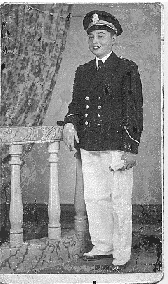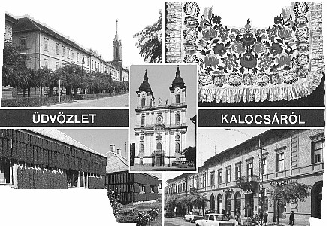

Csiba Károly, 11 éves, a kalocsai jezsuiták Szent István kollegiumának (nyári) díszruhájában 1940.
Charles Chiba,aged 11, in the parade (summer) uniform of the Jesuits' Szent István Kollegium, Kalocsa, Hungary in 1940.

Kalocsa az 1960-as években.
1) A Kollegium épülete a jezsuiták templomával. Az 1950-es években az állam elkobozta az épületet és börtönné alakították át. Ahol a villanyoszlop áll, az épület külső falán 1945-ig volt egy márvány emléktábla mely megörökítette a tizennyolc férfi akasztását a hirhedt kommunista tömeggyilkos Szamuelly és pribékei által.a rövidéletü 1919 bolsevista rémuralom alatt. Az akasztás folyamán, a fák feletti nyitott ablaknál hátrahúzódva, egy jezsuita pap adott utolsó feloldozást az áldozatonak.2) A híres kalocsai hímzés.
3) Kalocsa híres terméke, a magyar édes-nemes paprika.
4) Kalocsa hotel és restaurant épülete.
5) Betét: A kalocsai érseki székesegyház..
Kalocsa in the 1960s. 1) Building of the Kollegium with the Jesuits' church. It was confiscated by the State and converted to a prison during the 1950s. Just about where the telegraph pole is, on the outside of the building at chest hight, until 1945, there used to be a marble plaque that commemorated the hanging of eighteen men on the trees in front of the building by the infamous communist mass killer Szamuelly and his henchmen during the shortlived Bolshevik terror in Hungary in 1919. During the hanging, a Jesuit priest gave the last rites to the victims from behind a window just above the trees.
2) Kalocsa's famous needlework.
3) Kalocsa's unique product: the Hungarian sweet-noble paprika.
4) Kalocsa's hotel and restaurant row on the Main Street.
5) Insert: The Archbishop's Cathedral.